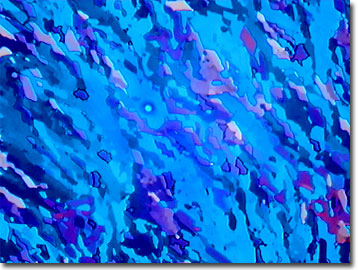Polarized Light Digital Image Gallery
Glutamic Acid
Glutamic acid, a negatively charged amino acid, is found often on the surface of proteins in plants and animals. As an important metabolic intermediate in animals, glutamic acid is a nonessential amino acid that can be biosynthesized during the metabolism of carbohydrates or obtained directly from dietary sources.

Glutamic acid can also be biosynthesized from a number of amino acids including ornithine and arginine. When aminated, glutamic acid forms the important amino acid glutamine. Because it has a carboxylic acid moiety on the side chain, glutamic acid is one of only two amino acids (the other being aspartic acid) that have a net negative charge at physiological pH. This negative charge makes glutamic acid a very polar molecule and it is usually found on the outside of proteins and enzymes where it is free to interact with the aqueous intracellular surroundings. On a molar basis, glutamic acid is incorporated into proteins at a rate of 6.2 percent compared to the other amino acids.
First isolated in 1865, glutamic acid is widely distributed in plants and some plant proteins yield as much as 45 percent of their weight as glutamic acid. Much of this content probably results from the presence of a related substance, glutamine, first isolated in 1932 from wheat proteins. Glutamine is the monoamide of glutamic acid, and an abundant constituent of proteins. When a protein is hydrolyzed, glutamine is converted to glutamic acid.
Glutamine is important for the cellular metabolism of animals. It is the only amino acid capable of readily crossing the blood-brain barrier and, with glutamic acid, is thought to account for about 80 percent of the amino nitrogen of brain tissue. Russian biochemist Alexander Braunstein, in 1937, discovered a new type of reversible enzyme-catalyzed reaction while studying glutamic acid metabolism in muscles. The transamination reaction is based on the transfer of the amino group of glutamic acid to a keto acid, to form a new amino acid and a new keto acid. Braunstein discovered that the loss of glutamate was accompanied by a decrease in lactic (aerobic) or pyruvic (under anaerobic conditions) acid. The new amino acid formed is alanine and the process was demonstrated to be reversible.
Sickle cell anemia is a hereditary disease caused by a point mutation or a change in one nucleotide within the sequence of 438 bases coding for the hemoglobin beta chain. A shift in the seventeenth nucleotide from a thymine (T) base to an adenine (A) base in the DNA of genes encoding hemoglobin causes a switch in the 6th amino acid, from glutamic acid to valine, in people with sickle cell anemia. The change of this one amino acid results in hemoglobin that has a tendency to clump together and alter the shape of red blood cells containing the mutated protein. A salt of glutamic acid, monosodium glutamate (MSG), is sometimes used as a preservative and condiment for flavoring foods such as Chinese cuisine, but some people suffer food allergies from the amino acid.
Contributing Authors
Omar Alvarado, Thomas J. Fellers and Michael W. Davidson - National High Magnetic Field Laboratory, 1800 East Paul Dirac Dr., The Florida State University, Tallahassee, Florida, 32310.
BACK TO THE POLARIZED LIGHT IMAGE GALLERY
BACK TO THE DIGITAL IMAGE GALLERIES
Questions or comments? Send us an email.
© 1995-2025 by Michael W. Davidson and The Florida State University. All Rights Reserved. No images, graphics, software, scripts, or applets may be reproduced or used in any manner without permission from the copyright holders. Use of this website means you agree to all of the Legal Terms and Conditions set forth by the owners.
This website is maintained by our
Graphics & Web Programming Team
in collaboration with Optical Microscopy at the
National High Magnetic Field Laboratory.
Last Modification Friday, Nov 13, 2015 at 01:19 PM
Access Count Since September 17, 2002: 18194
Visit the website of our partner in introductory microscopy education:
|
|
